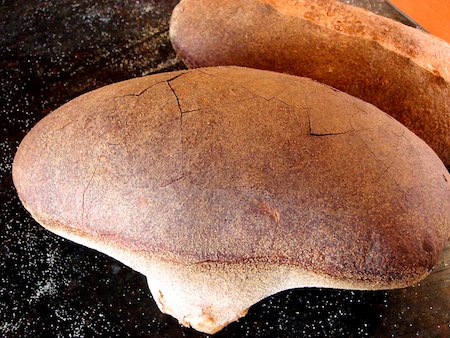
A blowout might be a good thing if you’re the birthday girl or the winning team, but when it comes to bread, usually not. In the scheme of things, a bread blowout may be a minor annoyance compared to, say, blowing out your front left tire on the freeway, but even so, I’d prefer not to have anything resembling the Goodyear Blimp on my dinner table.
My friend and baker extraordinaire Natashya (Living in the Kitchen With Puppies) asked me for help understanding why her loaves (of which the above is not one; I take full credit for that one) had exploded open like Aliens. I get asked this question fairly frequently, so here’s what I know (or I think I know) about it.
In general, a blowout happens when the crust sets before the inside has finished expanding. This can happen on the top, bottom, or side of the loaf. One or a combination of factors can be the culprit:
- Underproofing. Too much stretch left in the dough when it goes into the oven allows it to continue to expand past the point when the crust is set. Proofing time as stated in a recipe should always be used as a guideline, not an absolute time. If your room temperature and/or dough temperature differ significantly from those suggested in the recipe, the proofing time will, too. Most breads are well proofed when the indentation left by a fingertip springs back slowly, about halfway.
- No or insufficient scoring. In addition to making your loaves look pretty, scoring provides controlled locations for expansion. As we know often happens with other things, damming the floodgates can, paradoxically, lead to all hell breaking loose. The loaf in the photo above obviously wasn’t scored.
- Insufficient steam at the beginning of the bake. Steam delays the setting of the crust, allowing it to expand along with the interior of the loaf. The bread above also suffered from too little steam, another tipoff of which is the dullness of the crust. Here is some information on steaming your bread.
- Uneven oven temperature, or the loaves too crowded in the oven. This creates cool spots on the surface of the loaves, which are then perfect escape hatches for expanding dough. If you see blowouts on the sides where the loaves are closest together, this is almost certainly the cause.
I love having you as my font of information! A true Bread Baking Babe indeed, thanks so much for all the great tips! xoxo
Great info Susan, thank you. Always learn new thing from you.
Brilliant timing. I had a blow out yesterday and was pondering on allll the reasons why it was so. Thank you Susan.
Must be the week of the blow-out…
I had one myself, but since I’m baking under way less than ideal conditions, I take it as yet another bump in a very bumpy road. (sigh)
As I slowly learn more and more about yeast baking (by reading blog!) I love all the knew things I’m finding out. In my limited bread baking I haven’t had this problem but I like knowing about it, and knowing what to do to avoid it. Thanks!
I hadn’t thought of underproofing being a cause! Or overcrowding.
Many thanks for this, Susan. (And I know it’s wrong but I find it so comforting to see that even you manage to have blownout loaves.)